Rolls Royce and Aviation Sustainability: Evaluating EMS Implementation
VerifiedAdded on 2023/01/11
|7
|2005
|46
Essay
AI Summary
This essay critically evaluates Rolls Royce's approach to sustainable aviation and its implementation of Environmental Management Systems (EMSs). It examines the company's policies, plans, and initiatives aimed at reducing the environmental impact of air transportation. The essay discusses the importance of green technology in aviation manufacturing and how it contributes to a low-carbon, green-oriented industry. Rolls Royce's efforts in reducing emissions, developing green fuels, and investing in research and development for noise reduction and aerodynamic efficiency are highlighted. The analysis covers the company's strategies for improving fuel efficiency, supporting sustainable aviation fuels, and developing new aircraft and propulsion technologies. Ultimately, the essay concludes that Rolls Royce plays a significant role in promoting environmental sustainability within the aviation manufacturing sector, contributing to global efforts to reduce the industry's environmental footprint. Desklib provides this essay as a student resource, offering a platform for accessing similar solved assignments and study tools.
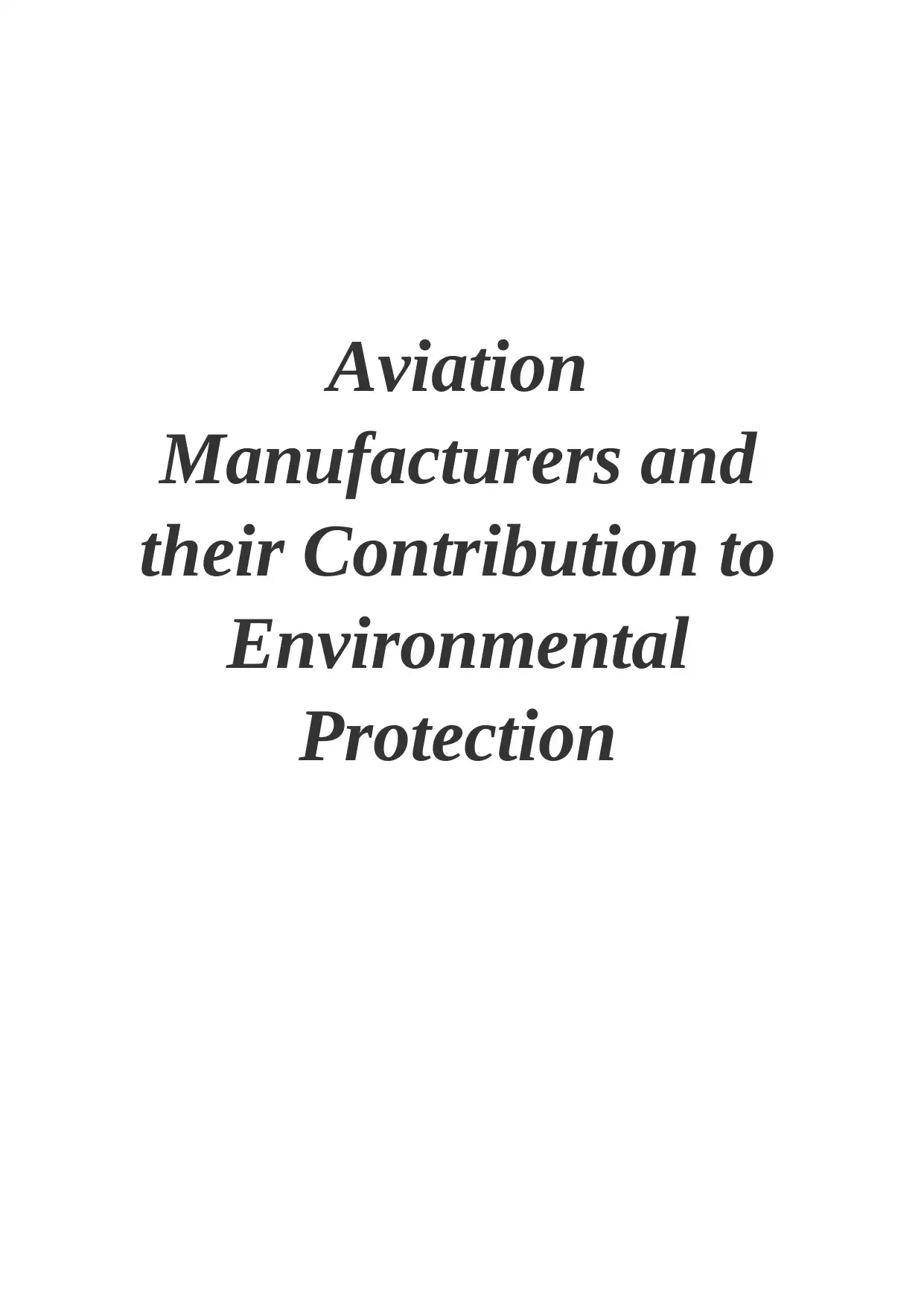
Aviation
Manufacturers and
their Contribution to
Environmental
Protection
Manufacturers and
their Contribution to
Environmental
Protection
Paraphrase This Document
Need a fresh take? Get an instant paraphrase of this document with our AI Paraphraser

Topic: “Aviation Manufacturers and their Contribution to Environmental Protection”..............3
INTRODUCTION...............................................................................................................................3
MAIN BODY.......................................................................................................................................3
CONCLUSION....................................................................................................................................4
REFERENCES....................................................................................................................................5
INTRODUCTION...............................................................................................................................3
MAIN BODY.......................................................................................................................................3
CONCLUSION....................................................................................................................................4
REFERENCES....................................................................................................................................5
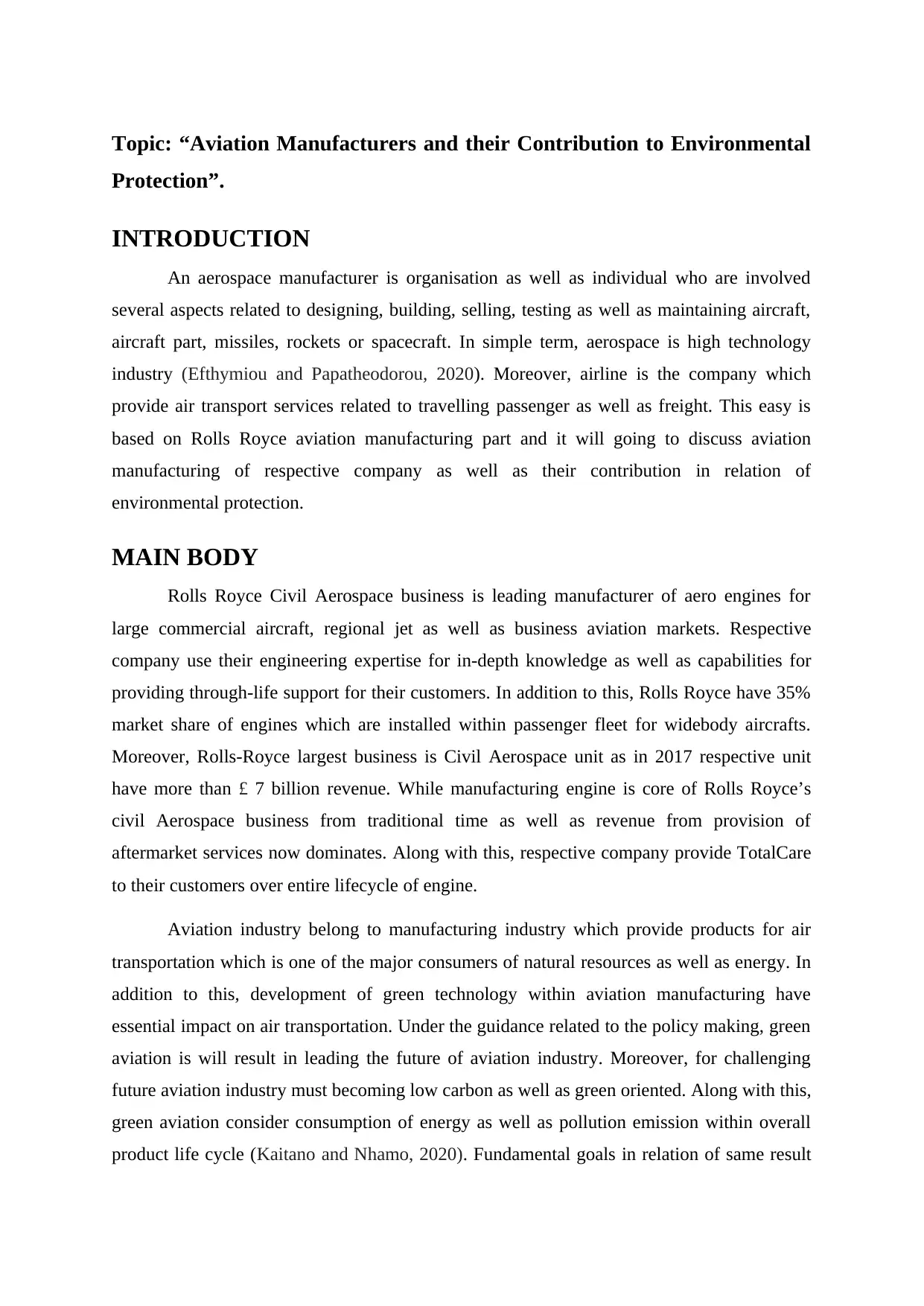
Topic: “Aviation Manufacturers and their Contribution to Environmental
Protection”.
INTRODUCTION
An aerospace manufacturer is organisation as well as individual who are involved
several aspects related to designing, building, selling, testing as well as maintaining aircraft,
aircraft part, missiles, rockets or spacecraft. In simple term, aerospace is high technology
industry (Efthymiou and Papatheodorou, 2020). Moreover, airline is the company which
provide air transport services related to travelling passenger as well as freight. This easy is
based on Rolls Royce aviation manufacturing part and it will going to discuss aviation
manufacturing of respective company as well as their contribution in relation of
environmental protection.
MAIN BODY
Rolls Royce Civil Aerospace business is leading manufacturer of aero engines for
large commercial aircraft, regional jet as well as business aviation markets. Respective
company use their engineering expertise for in-depth knowledge as well as capabilities for
providing through-life support for their customers. In addition to this, Rolls Royce have 35%
market share of engines which are installed within passenger fleet for widebody aircrafts.
Moreover, Rolls-Royce largest business is Civil Aerospace unit as in 2017 respective unit
have more than £ 7 billion revenue. While manufacturing engine is core of Rolls Royce’s
civil Aerospace business from traditional time as well as revenue from provision of
aftermarket services now dominates. Along with this, respective company provide TotalCare
to their customers over entire lifecycle of engine.
Aviation industry belong to manufacturing industry which provide products for air
transportation which is one of the major consumers of natural resources as well as energy. In
addition to this, development of green technology within aviation manufacturing have
essential impact on air transportation. Under the guidance related to the policy making, green
aviation is will result in leading the future of aviation industry. Moreover, for challenging
future aviation industry must becoming low carbon as well as green oriented. Along with this,
green aviation consider consumption of energy as well as pollution emission within overall
product life cycle (Kaitano and Nhamo, 2020). Fundamental goals in relation of same result
Protection”.
INTRODUCTION
An aerospace manufacturer is organisation as well as individual who are involved
several aspects related to designing, building, selling, testing as well as maintaining aircraft,
aircraft part, missiles, rockets or spacecraft. In simple term, aerospace is high technology
industry (Efthymiou and Papatheodorou, 2020). Moreover, airline is the company which
provide air transport services related to travelling passenger as well as freight. This easy is
based on Rolls Royce aviation manufacturing part and it will going to discuss aviation
manufacturing of respective company as well as their contribution in relation of
environmental protection.
MAIN BODY
Rolls Royce Civil Aerospace business is leading manufacturer of aero engines for
large commercial aircraft, regional jet as well as business aviation markets. Respective
company use their engineering expertise for in-depth knowledge as well as capabilities for
providing through-life support for their customers. In addition to this, Rolls Royce have 35%
market share of engines which are installed within passenger fleet for widebody aircrafts.
Moreover, Rolls-Royce largest business is Civil Aerospace unit as in 2017 respective unit
have more than £ 7 billion revenue. While manufacturing engine is core of Rolls Royce’s
civil Aerospace business from traditional time as well as revenue from provision of
aftermarket services now dominates. Along with this, respective company provide TotalCare
to their customers over entire lifecycle of engine.
Aviation industry belong to manufacturing industry which provide products for air
transportation which is one of the major consumers of natural resources as well as energy. In
addition to this, development of green technology within aviation manufacturing have
essential impact on air transportation. Under the guidance related to the policy making, green
aviation is will result in leading the future of aviation industry. Moreover, for challenging
future aviation industry must becoming low carbon as well as green oriented. Along with this,
green aviation consider consumption of energy as well as pollution emission within overall
product life cycle (Kaitano and Nhamo, 2020). Fundamental goals in relation of same result
⊘ This is a preview!⊘
Do you want full access?
Subscribe today to unlock all pages.

Trusted by 1+ million students worldwide
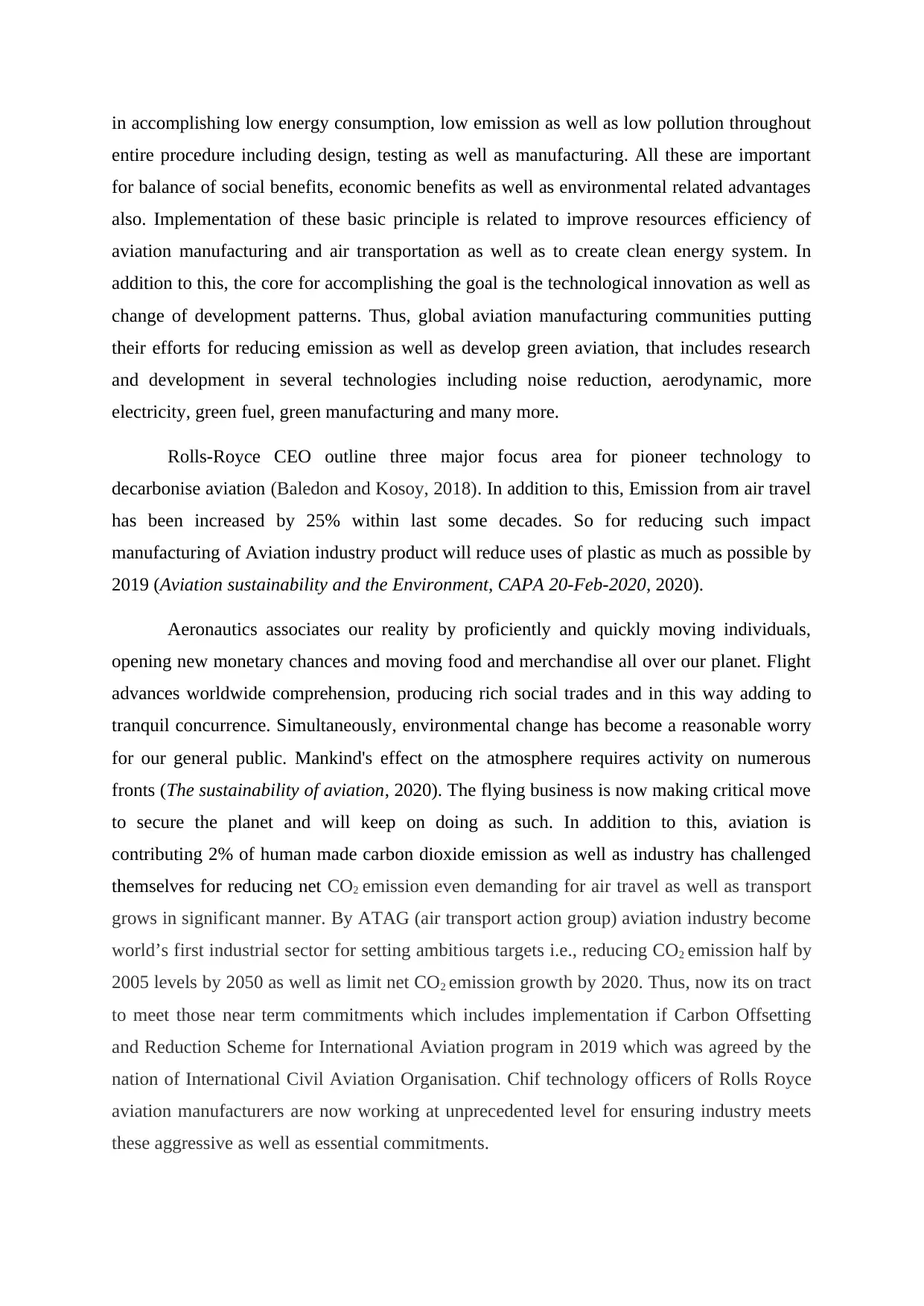
in accomplishing low energy consumption, low emission as well as low pollution throughout
entire procedure including design, testing as well as manufacturing. All these are important
for balance of social benefits, economic benefits as well as environmental related advantages
also. Implementation of these basic principle is related to improve resources efficiency of
aviation manufacturing and air transportation as well as to create clean energy system. In
addition to this, the core for accomplishing the goal is the technological innovation as well as
change of development patterns. Thus, global aviation manufacturing communities putting
their efforts for reducing emission as well as develop green aviation, that includes research
and development in several technologies including noise reduction, aerodynamic, more
electricity, green fuel, green manufacturing and many more.
Rolls-Royce CEO outline three major focus area for pioneer technology to
decarbonise aviation (Baledon and Kosoy, 2018). In addition to this, Emission from air travel
has been increased by 25% within last some decades. So for reducing such impact
manufacturing of Aviation industry product will reduce uses of plastic as much as possible by
2019 (Aviation sustainability and the Environment, CAPA 20-Feb-2020, 2020).
Aeronautics associates our reality by proficiently and quickly moving individuals,
opening new monetary chances and moving food and merchandise all over our planet. Flight
advances worldwide comprehension, producing rich social trades and in this way adding to
tranquil concurrence. Simultaneously, environmental change has become a reasonable worry
for our general public. Mankind's effect on the atmosphere requires activity on numerous
fronts (The sustainability of aviation, 2020). The flying business is now making critical move
to secure the planet and will keep on doing as such. In addition to this, aviation is
contributing 2% of human made carbon dioxide emission as well as industry has challenged
themselves for reducing net CO2 emission even demanding for air travel as well as transport
grows in significant manner. By ATAG (air transport action group) aviation industry become
world’s first industrial sector for setting ambitious targets i.e., reducing CO2 emission half by
2005 levels by 2050 as well as limit net CO2 emission growth by 2020. Thus, now its on tract
to meet those near term commitments which includes implementation if Carbon Offsetting
and Reduction Scheme for International Aviation program in 2019 which was agreed by the
nation of International Civil Aviation Organisation. Chif technology officers of Rolls Royce
aviation manufacturers are now working at unprecedented level for ensuring industry meets
these aggressive as well as essential commitments.
entire procedure including design, testing as well as manufacturing. All these are important
for balance of social benefits, economic benefits as well as environmental related advantages
also. Implementation of these basic principle is related to improve resources efficiency of
aviation manufacturing and air transportation as well as to create clean energy system. In
addition to this, the core for accomplishing the goal is the technological innovation as well as
change of development patterns. Thus, global aviation manufacturing communities putting
their efforts for reducing emission as well as develop green aviation, that includes research
and development in several technologies including noise reduction, aerodynamic, more
electricity, green fuel, green manufacturing and many more.
Rolls-Royce CEO outline three major focus area for pioneer technology to
decarbonise aviation (Baledon and Kosoy, 2018). In addition to this, Emission from air travel
has been increased by 25% within last some decades. So for reducing such impact
manufacturing of Aviation industry product will reduce uses of plastic as much as possible by
2019 (Aviation sustainability and the Environment, CAPA 20-Feb-2020, 2020).
Aeronautics associates our reality by proficiently and quickly moving individuals,
opening new monetary chances and moving food and merchandise all over our planet. Flight
advances worldwide comprehension, producing rich social trades and in this way adding to
tranquil concurrence. Simultaneously, environmental change has become a reasonable worry
for our general public. Mankind's effect on the atmosphere requires activity on numerous
fronts (The sustainability of aviation, 2020). The flying business is now making critical move
to secure the planet and will keep on doing as such. In addition to this, aviation is
contributing 2% of human made carbon dioxide emission as well as industry has challenged
themselves for reducing net CO2 emission even demanding for air travel as well as transport
grows in significant manner. By ATAG (air transport action group) aviation industry become
world’s first industrial sector for setting ambitious targets i.e., reducing CO2 emission half by
2005 levels by 2050 as well as limit net CO2 emission growth by 2020. Thus, now its on tract
to meet those near term commitments which includes implementation if Carbon Offsetting
and Reduction Scheme for International Aviation program in 2019 which was agreed by the
nation of International Civil Aviation Organisation. Chif technology officers of Rolls Royce
aviation manufacturers are now working at unprecedented level for ensuring industry meets
these aggressive as well as essential commitments.
Paraphrase This Document
Need a fresh take? Get an instant paraphrase of this document with our AI Paraphraser
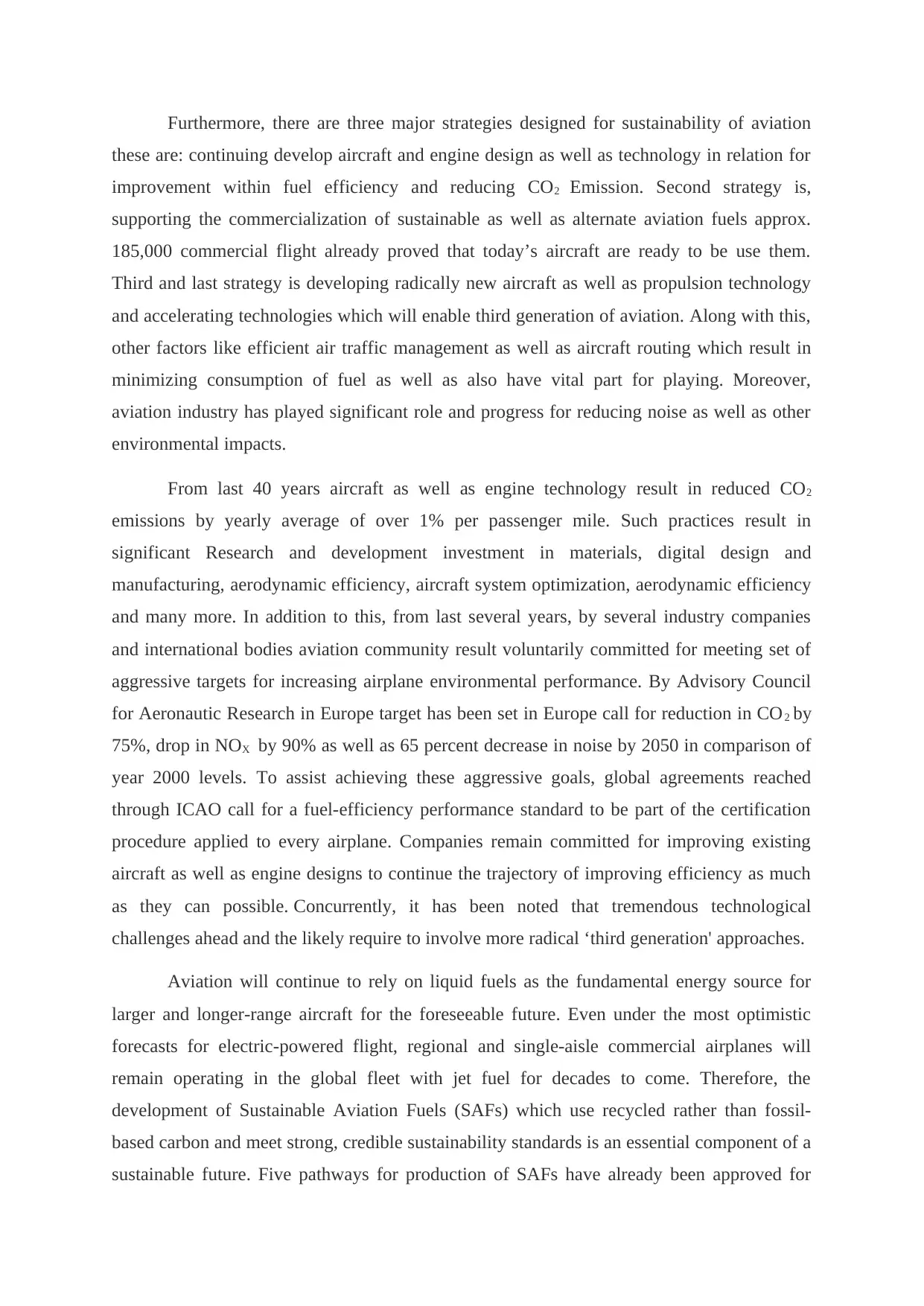
Furthermore, there are three major strategies designed for sustainability of aviation
these are: continuing develop aircraft and engine design as well as technology in relation for
improvement within fuel efficiency and reducing CO2 Emission. Second strategy is,
supporting the commercialization of sustainable as well as alternate aviation fuels approx.
185,000 commercial flight already proved that today’s aircraft are ready to be use them.
Third and last strategy is developing radically new aircraft as well as propulsion technology
and accelerating technologies which will enable third generation of aviation. Along with this,
other factors like efficient air traffic management as well as aircraft routing which result in
minimizing consumption of fuel as well as also have vital part for playing. Moreover,
aviation industry has played significant role and progress for reducing noise as well as other
environmental impacts.
From last 40 years aircraft as well as engine technology result in reduced CO2
emissions by yearly average of over 1% per passenger mile. Such practices result in
significant Research and development investment in materials, digital design and
manufacturing, aerodynamic efficiency, aircraft system optimization, aerodynamic efficiency
and many more. In addition to this, from last several years, by several industry companies
and international bodies aviation community result voluntarily committed for meeting set of
aggressive targets for increasing airplane environmental performance. By Advisory Council
for Aeronautic Research in Europe target has been set in Europe call for reduction in CO2 by
75%, drop in NOX by 90% as well as 65 percent decrease in noise by 2050 in comparison of
year 2000 levels. To assist achieving these aggressive goals, global agreements reached
through ICAO call for a fuel-efficiency performance standard to be part of the certification
procedure applied to every airplane. Companies remain committed for improving existing
aircraft as well as engine designs to continue the trajectory of improving efficiency as much
as they can possible. Concurrently, it has been noted that tremendous technological
challenges ahead and the likely require to involve more radical ‘third generation' approaches.
Aviation will continue to rely on liquid fuels as the fundamental energy source for
larger and longer-range aircraft for the foreseeable future. Even under the most optimistic
forecasts for electric-powered flight, regional and single-aisle commercial airplanes will
remain operating in the global fleet with jet fuel for decades to come. Therefore, the
development of Sustainable Aviation Fuels (SAFs) which use recycled rather than fossil-
based carbon and meet strong, credible sustainability standards is an essential component of a
sustainable future. Five pathways for production of SAFs have already been approved for
these are: continuing develop aircraft and engine design as well as technology in relation for
improvement within fuel efficiency and reducing CO2 Emission. Second strategy is,
supporting the commercialization of sustainable as well as alternate aviation fuels approx.
185,000 commercial flight already proved that today’s aircraft are ready to be use them.
Third and last strategy is developing radically new aircraft as well as propulsion technology
and accelerating technologies which will enable third generation of aviation. Along with this,
other factors like efficient air traffic management as well as aircraft routing which result in
minimizing consumption of fuel as well as also have vital part for playing. Moreover,
aviation industry has played significant role and progress for reducing noise as well as other
environmental impacts.
From last 40 years aircraft as well as engine technology result in reduced CO2
emissions by yearly average of over 1% per passenger mile. Such practices result in
significant Research and development investment in materials, digital design and
manufacturing, aerodynamic efficiency, aircraft system optimization, aerodynamic efficiency
and many more. In addition to this, from last several years, by several industry companies
and international bodies aviation community result voluntarily committed for meeting set of
aggressive targets for increasing airplane environmental performance. By Advisory Council
for Aeronautic Research in Europe target has been set in Europe call for reduction in CO2 by
75%, drop in NOX by 90% as well as 65 percent decrease in noise by 2050 in comparison of
year 2000 levels. To assist achieving these aggressive goals, global agreements reached
through ICAO call for a fuel-efficiency performance standard to be part of the certification
procedure applied to every airplane. Companies remain committed for improving existing
aircraft as well as engine designs to continue the trajectory of improving efficiency as much
as they can possible. Concurrently, it has been noted that tremendous technological
challenges ahead and the likely require to involve more radical ‘third generation' approaches.
Aviation will continue to rely on liquid fuels as the fundamental energy source for
larger and longer-range aircraft for the foreseeable future. Even under the most optimistic
forecasts for electric-powered flight, regional and single-aisle commercial airplanes will
remain operating in the global fleet with jet fuel for decades to come. Therefore, the
development of Sustainable Aviation Fuels (SAFs) which use recycled rather than fossil-
based carbon and meet strong, credible sustainability standards is an essential component of a
sustainable future. Five pathways for production of SAFs have already been approved for
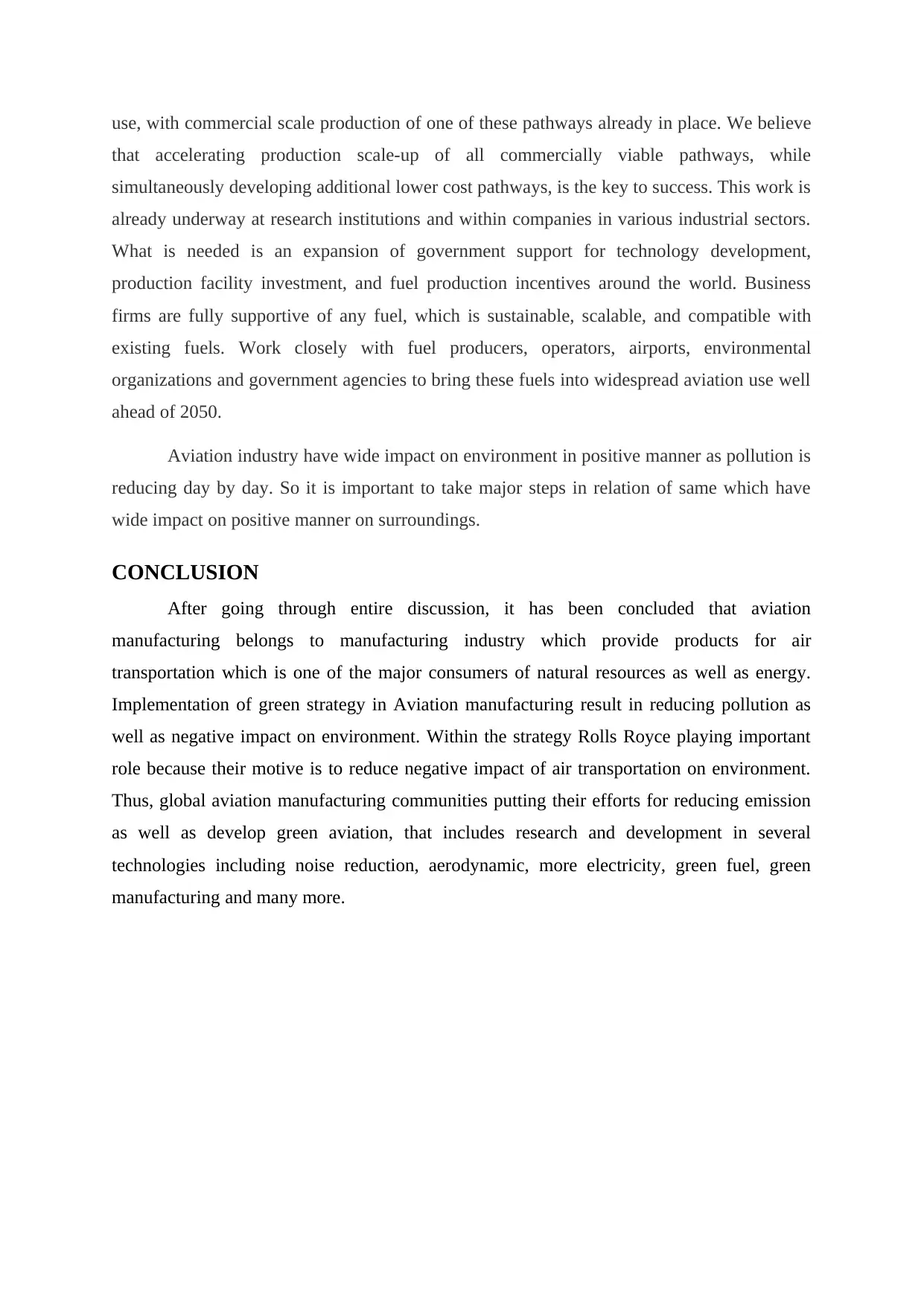
use, with commercial scale production of one of these pathways already in place. We believe
that accelerating production scale-up of all commercially viable pathways, while
simultaneously developing additional lower cost pathways, is the key to success. This work is
already underway at research institutions and within companies in various industrial sectors.
What is needed is an expansion of government support for technology development,
production facility investment, and fuel production incentives around the world. Business
firms are fully supportive of any fuel, which is sustainable, scalable, and compatible with
existing fuels. Work closely with fuel producers, operators, airports, environmental
organizations and government agencies to bring these fuels into widespread aviation use well
ahead of 2050.
Aviation industry have wide impact on environment in positive manner as pollution is
reducing day by day. So it is important to take major steps in relation of same which have
wide impact on positive manner on surroundings.
CONCLUSION
After going through entire discussion, it has been concluded that aviation
manufacturing belongs to manufacturing industry which provide products for air
transportation which is one of the major consumers of natural resources as well as energy.
Implementation of green strategy in Aviation manufacturing result in reducing pollution as
well as negative impact on environment. Within the strategy Rolls Royce playing important
role because their motive is to reduce negative impact of air transportation on environment.
Thus, global aviation manufacturing communities putting their efforts for reducing emission
as well as develop green aviation, that includes research and development in several
technologies including noise reduction, aerodynamic, more electricity, green fuel, green
manufacturing and many more.
that accelerating production scale-up of all commercially viable pathways, while
simultaneously developing additional lower cost pathways, is the key to success. This work is
already underway at research institutions and within companies in various industrial sectors.
What is needed is an expansion of government support for technology development,
production facility investment, and fuel production incentives around the world. Business
firms are fully supportive of any fuel, which is sustainable, scalable, and compatible with
existing fuels. Work closely with fuel producers, operators, airports, environmental
organizations and government agencies to bring these fuels into widespread aviation use well
ahead of 2050.
Aviation industry have wide impact on environment in positive manner as pollution is
reducing day by day. So it is important to take major steps in relation of same which have
wide impact on positive manner on surroundings.
CONCLUSION
After going through entire discussion, it has been concluded that aviation
manufacturing belongs to manufacturing industry which provide products for air
transportation which is one of the major consumers of natural resources as well as energy.
Implementation of green strategy in Aviation manufacturing result in reducing pollution as
well as negative impact on environment. Within the strategy Rolls Royce playing important
role because their motive is to reduce negative impact of air transportation on environment.
Thus, global aviation manufacturing communities putting their efforts for reducing emission
as well as develop green aviation, that includes research and development in several
technologies including noise reduction, aerodynamic, more electricity, green fuel, green
manufacturing and many more.
⊘ This is a preview!⊘
Do you want full access?
Subscribe today to unlock all pages.

Trusted by 1+ million students worldwide
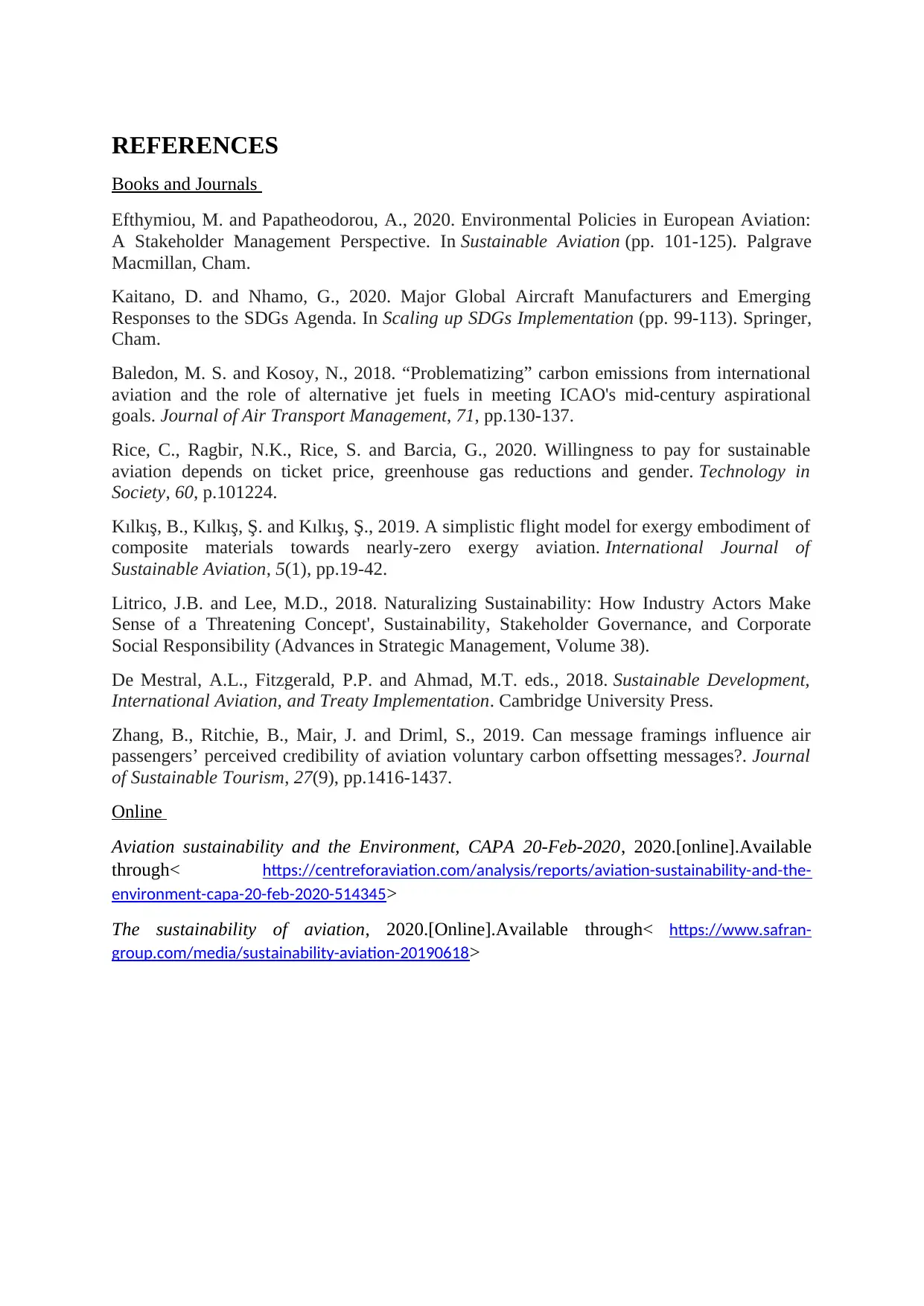
REFERENCES
Books and Journals
Efthymiou, M. and Papatheodorou, A., 2020. Environmental Policies in European Aviation:
A Stakeholder Management Perspective. In Sustainable Aviation (pp. 101-125). Palgrave
Macmillan, Cham.
Kaitano, D. and Nhamo, G., 2020. Major Global Aircraft Manufacturers and Emerging
Responses to the SDGs Agenda. In Scaling up SDGs Implementation (pp. 99-113). Springer,
Cham.
Baledon, M. S. and Kosoy, N., 2018. “Problematizing” carbon emissions from international
aviation and the role of alternative jet fuels in meeting ICAO's mid-century aspirational
goals. Journal of Air Transport Management, 71, pp.130-137.
Rice, C., Ragbir, N.K., Rice, S. and Barcia, G., 2020. Willingness to pay for sustainable
aviation depends on ticket price, greenhouse gas reductions and gender. Technology in
Society, 60, p.101224.
Kılkış, B., Kılkış, Ş. and Kılkış, Ş., 2019. A simplistic flight model for exergy embodiment of
composite materials towards nearly-zero exergy aviation. International Journal of
Sustainable Aviation, 5(1), pp.19-42.
Litrico, J.B. and Lee, M.D., 2018. Naturalizing Sustainability: How Industry Actors Make
Sense of a Threatening Concept', Sustainability, Stakeholder Governance, and Corporate
Social Responsibility (Advances in Strategic Management, Volume 38).
De Mestral, A.L., Fitzgerald, P.P. and Ahmad, M.T. eds., 2018. Sustainable Development,
International Aviation, and Treaty Implementation. Cambridge University Press.
Zhang, B., Ritchie, B., Mair, J. and Driml, S., 2019. Can message framings influence air
passengers’ perceived credibility of aviation voluntary carbon offsetting messages?. Journal
of Sustainable Tourism, 27(9), pp.1416-1437.
Online
Aviation sustainability and the Environment, CAPA 20-Feb-2020, 2020.[online].Available
through< https://centreforaviation.com/analysis/reports/aviation-sustainability-and-the-
environment-capa-20-feb-2020-514345>
The sustainability of aviation, 2020.[Online].Available through< https://www.safran-
group.com/media/sustainability-aviation-20190618>
Books and Journals
Efthymiou, M. and Papatheodorou, A., 2020. Environmental Policies in European Aviation:
A Stakeholder Management Perspective. In Sustainable Aviation (pp. 101-125). Palgrave
Macmillan, Cham.
Kaitano, D. and Nhamo, G., 2020. Major Global Aircraft Manufacturers and Emerging
Responses to the SDGs Agenda. In Scaling up SDGs Implementation (pp. 99-113). Springer,
Cham.
Baledon, M. S. and Kosoy, N., 2018. “Problematizing” carbon emissions from international
aviation and the role of alternative jet fuels in meeting ICAO's mid-century aspirational
goals. Journal of Air Transport Management, 71, pp.130-137.
Rice, C., Ragbir, N.K., Rice, S. and Barcia, G., 2020. Willingness to pay for sustainable
aviation depends on ticket price, greenhouse gas reductions and gender. Technology in
Society, 60, p.101224.
Kılkış, B., Kılkış, Ş. and Kılkış, Ş., 2019. A simplistic flight model for exergy embodiment of
composite materials towards nearly-zero exergy aviation. International Journal of
Sustainable Aviation, 5(1), pp.19-42.
Litrico, J.B. and Lee, M.D., 2018. Naturalizing Sustainability: How Industry Actors Make
Sense of a Threatening Concept', Sustainability, Stakeholder Governance, and Corporate
Social Responsibility (Advances in Strategic Management, Volume 38).
De Mestral, A.L., Fitzgerald, P.P. and Ahmad, M.T. eds., 2018. Sustainable Development,
International Aviation, and Treaty Implementation. Cambridge University Press.
Zhang, B., Ritchie, B., Mair, J. and Driml, S., 2019. Can message framings influence air
passengers’ perceived credibility of aviation voluntary carbon offsetting messages?. Journal
of Sustainable Tourism, 27(9), pp.1416-1437.
Online
Aviation sustainability and the Environment, CAPA 20-Feb-2020, 2020.[online].Available
through< https://centreforaviation.com/analysis/reports/aviation-sustainability-and-the-
environment-capa-20-feb-2020-514345>
The sustainability of aviation, 2020.[Online].Available through< https://www.safran-
group.com/media/sustainability-aviation-20190618>
1 out of 7
Related Documents
Your All-in-One AI-Powered Toolkit for Academic Success.
+13062052269
info@desklib.com
Available 24*7 on WhatsApp / Email
![[object Object]](/_next/static/media/star-bottom.7253800d.svg)
Unlock your academic potential
Copyright © 2020–2025 A2Z Services. All Rights Reserved. Developed and managed by ZUCOL.





